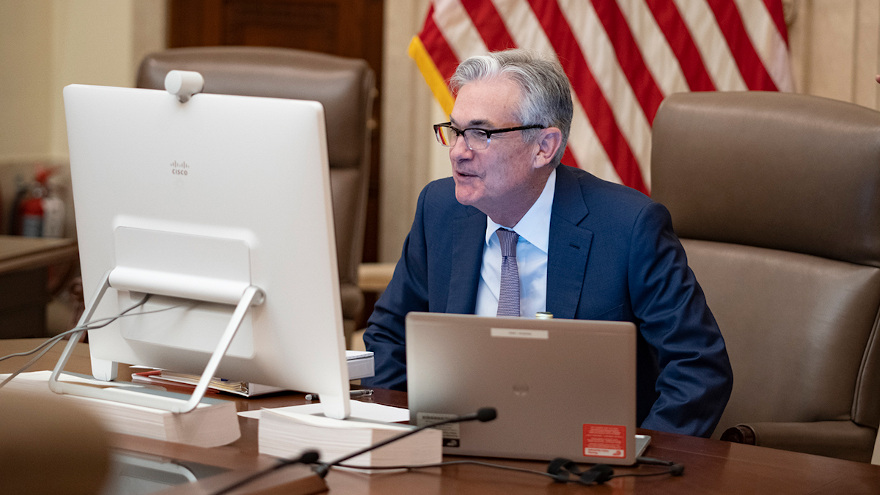Fed statement about longer-run goals seen as path ‘to avoid mistakes’

Federal Reserve chair Jerome Powell is seen conversing Federal Open Market Committee (FOMC) members during video conference in June. Photo courtesy of the Federal Reserve.
In what one observer described as a policymaker trying “to avoid mistakes of the past,” the Federal Reserve gave an update about how it plans to craft its actions for the next five years.
Following an extensive review that included numerous public events across the country, the Federal Open Market Committee (FOMC) on Thursday announced the unanimous approval of updates to its statement on longer-run goals and monetary policy strategy, which articulates its approach to monetary policy and serves as the foundation for its policy actions.
The Fed explained the updates reflect changes in the economy over the past decade and how policymakers are taking these changes into account in conducting monetary policy. The updated statement is also intended to enhance the transparency, accountability and effectiveness of monetary policy.
“The economy is always evolving, and the FOMC’s strategy for achieving its goals must adapt to meet the new challenges that arise,” Federal Reserve chair Jerome Powell said in a news release. “Our revised statement reflects our appreciation for the benefits of a strong labor market, particularly for many in low- and moderate-income communities, and that a robust job market can be sustained without causing an unwelcome increase in inflation.”
Among the more significant changes to the framework document are:
— On maximum employment, the FOMC emphasized that maximum employment is a broad-based and inclusive goal and reports that its policy decision will be informed by its “assessments of the shortfalls of employment from its maximum level.” The original document referred to “deviations from its maximum level.”
— On price stability, the FOMC adjusted its strategy for achieving its longer-run inflation goal of 2% by noting that it “seeks to achieve inflation that averages 2 percent over time.” To this end, the revised statement states that “following periods when inflation has been running persistently below 2 percent, appropriate monetary policy will likely aim to achieve inflation moderately above 2 percent for some time.”
—The updates to the strategy statement explicitly acknowledge the challenges for monetary policy posed by a persistently low-interest rate environment. Here in the United States and around the world, monetary policy interest rates are more likely to be constrained by their effective lower-bound than in the past.
The committee first adopted a framework statement in 2012.
Powell announced this first public review of the FOMC framework back in November 2018, involving three distinct components.
First, the Federal Reserve hosted a series of 15 Fed Listens events across the country to engage with employee groups and union members, small business owners, residents of low- and moderate-income communities, retirees, and others to hear a wide range of perspectives about how monetary policy decisions affect their communities. A report summarizing all of those events is available here.
Second, the Federal Reserve last June convened a research conference where prominent academic experts addressed economic topics central to the review. That conference program, links to the conference papers and presentations, and links to session videos are available here.
Then, the FOMC explored the range of issues that were brought to light during the course of the review in five consecutive meetings beginning last July. Analytical staff work put together by teams across the Federal Reserve System provided essential background for the committee’s discussions. Minutes of those meetings are available here and a collection of those papers is available here.
The FOMC reported it would continue its practice of considering the Statement of Longer-Run Goals and Policy each January and that it intends to undertake a public review of its monetary policy strategy, tools, and communication practices roughly every five years.
Curt Long, who is chief economist and vice president of research at the National Association of Federally-Insured Credit Unions (NAFCU), offered his assessment of the Fed’s intentions.
“The FOMC’s new framework looks to avoid mistakes of the past,” Long said in a news release. “Where some of the tightening which took place during the last cycle was done to short-circuit the inflation that policymakers thought was right around the corner, now they will wait until those stresses manifest more fully before raising rates.
“In focusing on ‘shortfalls’ rather than ‘deviations’ from full employment, it orients the Fed to pursue a tighter labor market without worrying so much about its potential to drive price increases,” Long went on to say.

 View The Latest Edition
View The Latest Edition

